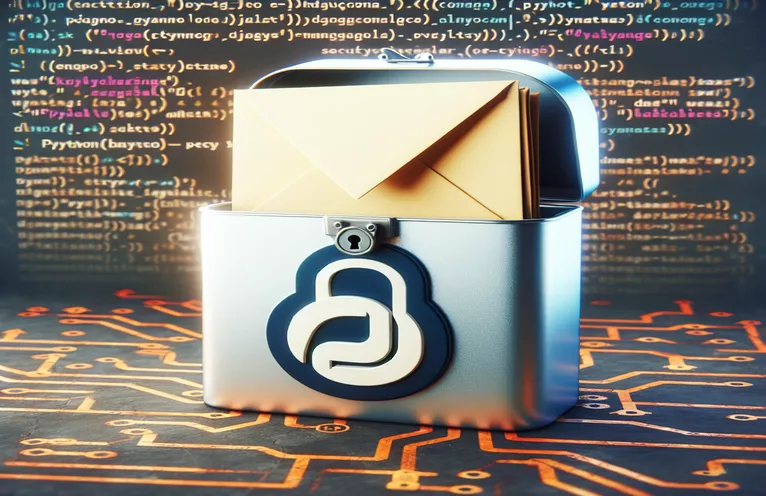Storing Credentials Securely
Especially for novices, handling private data when creating with Django, like email credentials, might be challenging. It is essential to protect these credentials while preserving their functioning. Sensitive information can be kept out of the codebase by using environment variables, which is a popular method.
However, obstacles such as misidentified modules and implementation flaws may cast doubt on the viability of this approach. Looking at other options, such connecting straight with email APIs, can provide a more reliable and safe way to manage credentials in your Django apps.
| Command | Description |
|---|---|
| from decouple import config | 'config' function from 'decouple' library is imported in order to safely retrieve environment variables. |
| send_mail | Used to create and send emails, this function comes from the Django email backend. |
| from google.oauth2 import service_account | To manage Google API credentials, imports the service account feature from the Google auth library. |
| build('gmail', 'v1', credentials=credentials) | Creates the Gmail API service object with the given version and API access credentials. |
| base64.urlsafe_b64encode | Encodes email message bytes into the base64 format that the Gmail API requires, which is safe for URLs. |
| service.users().messages().send() | To send an email using the created service object and the Gmail API, call the method. |
Comprehending Script Features and Utilizing Commands
The initial script makes use of environment variables to protect email credentials, which are essential to the security plan of any application. Basic commands like from decouple import config import the 'config' method from the 'python-decouple' package, which allows access to variables that are stored outside of the source code and protects private data like email credentials. Then, using these secured settings, the Django send_mail function is utilized to send emails without hardcoding sensitive information into the source code itself.
In order to send emails, the second script shows how to integrate with the Google API. This approach avoids keeping confidential email credentials within the application. With Google's suggested OAuth 2.0 approach, authentication is handled by this method using the from google.oauth2 import service_account. After that, it uses build('gmail', 'v1', credentials=credentials) to create a Gmail service object, allowing the application to communicate with Google's email sending features. Then, using API calls, commands like base64.urlsafe_b64encode and service.users().messages().send() are used to prepare and deliver emails safely.
Keeping Secure Email Credentials in Django
Python and Django Implementation
import osfrom decouple import configfrom django.core.mail import send_mail# Load environment variablesEMAIL_HOST_USER = config('EMAIL_HOST_USER')EMAIL_HOST_PASSWORD = config('EMAIL_HOST_PASSWORD')EMAIL_HOST = 'smtp.gmail.com'EMAIL_PORT = 587EMAIL_USE_TLS = True# Configure email in settings.pyEMAIL_BACKEND = 'django.core.mail.backends.smtp.EmailBackend'EMAIL_HOST = EMAIL_HOSTEMAIL_PORT = EMAIL_PORTEMAIL_HOST_USER = EMAIL_HOST_USEREMAIL_HOST_PASSWORD = EMAIL_HOST_PASSWORDEMAIL_USE_TLS = EMAIL_USE_TLS# Sending an emailsend_mail('Subject here','Here is the message.',EMAIL_HOST_USER,['to@example.com'],fail_silently=False,)
Google API Email Integration with Django
Python with Google API Utilization
from google.oauth2 import service_accountfrom googleapiclient.discovery import buildimport base64from email.mime.text import MIMEText# Setup the Gmail APISCOPES = ['https://www.googleapis.com/auth/gmail.send']SERVICE_ACCOUNT_FILE = 'path/to/service.json'credentials = service_account.Credentials.from_service_account_file(SERVICE_ACCOUNT_FILE, scopes=SCOPES)service = build('gmail', 'v1', credentials=credentials)# Create a messagedef create_message(sender, to, subject, message_text):message = MIMEText(message_text)message['to'] = tomessage['from'] = sendermessage['subject'] = subjectreturn {'raw': base64.urlsafe_b64encode(message.as_bytes()).decode()}# Send the messagedef send_message(service, user_id, message):try:message = (service.users().messages().send(userId=user_id, body=message).execute())print('Message Id: %s' % message['id'])return messageexcept Exception as error:print('An error occurred: %s' % error)
Different Approaches to Email Credential Security
Encrypted configuration files or secure vault services are other methods for protecting email credentials in Django, in addition to environment variables and direct API interfaces. Configuration files that are encrypted guarantee that private data is safeguarded even in the event of illegal access. Encrypt and decode sensitive data programmatically using tools like Ansible Vault, HashiCorp Vault, or even Python's built-in Fernet symmetric encryption from the cryptography package.
A centralized method for managing and storing secrets is offered by using a service like HashiCorp Vault, which can also handle access to secrets with strong audit logs and policies. This solution can be easily included into a Django project and reduces the possibility of email credentials being exposed either directly within the application or through less secure methods.
Common Questions about Django's Email Credential Management System
- In a Django project, how should email credentials be stored the safest way possible?
- It's regarded as safe to use environment variables with encryption, such python-decouple for loading and cryptography for encryption.
- How can I utilize my email credentials using environment variables?
- To safely load credentials into your Django settings, save them in a .env file and utilize a library like python-decouple.
- Is it possible to send emails using the Google API without saving my credentials?
- Yes, it is possible to send emails without directly storing email passwords when you use OAuth 2.0 authentication with Google’s API.
- What advantages come with combining Django with HashiCorp Vault?
- Sensitive data management is made easier with HashiCorp Vault's fine-grained access control, transparent audit trail, and secure secret storage.
- Is it OK to use Django to hardcode email credentials?
- No, hard-coding credentials puts private information at risk of security breaches. Use safe storage techniques at all times.
Concluding Remarks on Credential Storage Techniques
To securely store sensitive data, you must use safe storage techniques while managing credentials in Django. Using environment variables, encrypted files, or third-party APIs like Google's, each approach provides a different level of security to meet certain requirements. In order to determine the most suitable and secure method for managing credentials, developers need to evaluate the needs of their project as well as the security requirements.


